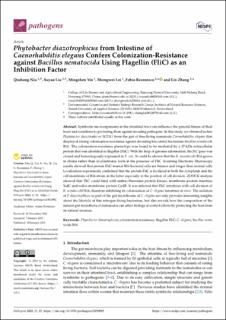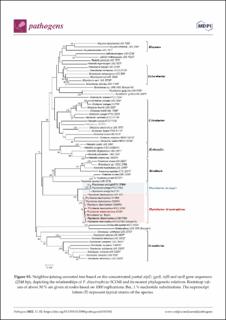Please use this identifier to cite or link to this item:
https://doi.org/10.21256/zhaw-23927| Publication type: | Article in scientific journal |
| Type of review: | Open peer review |
| Title: | Phytobacter diazotrophicus from intestine of Caenorhabditis elegans confers colonization-resistance against Bacillus nematocida using flagellin (FliC) as an inhibition factor |
| Authors: | Niu, Qiuhong Liu, Suyao Yin, Mingshen Lei, Shengwei Rezzonico, Fabio Zhang, Lin |
| et. al: | No |
| DOI: | 10.3390/pathogens11010082 10.21256/zhaw-23927 |
| Published in: | Pathogens |
| Volume(Issue): | 11 |
| Issue: | 1 |
| Page(s): | 82 |
| Issue Date: | 10-Jan-2022 |
| Publisher / Ed. Institution: | MDPI |
| ISSN: | 2076-0817 |
| Language: | English |
| Subjects: | Phytobacter diazotrophicus; Colonization-resistance; Flagellin FliC; C. elegans; Bacillus nematocida B16 |
| Subject (DDC): | 579: Microbiology |
| Abstract: | Symbiotic microorganisms in the intestinal tract can influence the general fitness of their hosts and contribute to protecting them against invading pathogens. In this study, we obtained isolate Phytobacter diazotrophicus SCO41 from the gut of free-living nematode Caenorhabditis elegans that displayed strong colonization-resistance against invading biocontrol bacterium Bacillus nematocida B16. The colonization-resistance phenotype was found to be mediated by a 37-kDa extracellular protein that was identified as flagellin (FliC). With the help of genome information, the fliC gene was cloned and heterologously expressed in E. coli. It could be shown that the B. nematocida B16 grows in chains rather than in planktonic form in the presence of FliC. Scanning Electronic Microscopy results showed that protein FliC-treated B16 bacterial cells are thinner and longer than normal cells. Localization experiments confirmed that the protein FliC is localized in both the cytoplasm and the cell membrane of B16 strain, in the latter especially at the position of cell division. ZDOCK analysis showed that FliC could bind with serine/threonine protein kinase, membrane protein insertase YidC and redox membrane protein CydB. It was inferred that FliC interferes with cell division of B. nematocidal B16, therefore inhibiting its colonization of C. elegans intestines in vivo. The isolation of P. diazotrophicus as part of the gut microbiome of C. elegans not only provides interesting insights about the lifestyle of this nitrogen-fixing bacterium, but also reveals how the composition of the natural gut microbiota of nematodes can affect biological control efforts by protecting the host from its natural enemies. |
| URI: | https://digitalcollection.zhaw.ch/handle/11475/23927 |
| Fulltext version: | Published version |
| License (according to publishing contract): | CC BY 4.0: Attribution 4.0 International |
| Departement: | Life Sciences and Facility Management |
| Organisational Unit: | Institute of Natural Resource Sciences (IUNR) |
| Published as part of the ZHAW project: | Antibiotic resistances in Enterobacteria |
| Appears in collections: | Publikationen Life Sciences und Facility Management |
Files in This Item:
| File | Description | Size | Format | |
|---|---|---|---|---|
| 2022_Niu-etal_Colonization-resistance_Pathogens.pdf | Article | 4.42 MB | Adobe PDF |  View/Open |
| 2022_Niu-etal_Colonization-resistance-Supplement.pdf | Supplementary Material | 342.77 kB | Adobe PDF |  View/Open |
Show full item record
Niu, Q., Liu, S., Yin, M., Lei, S., Rezzonico, F., & Zhang, L. (2022). Phytobacter diazotrophicus from intestine of Caenorhabditis elegans confers colonization-resistance against Bacillus nematocida using flagellin (FliC) as an inhibition factor. Pathogens, 11(1), 82. https://doi.org/10.3390/pathogens11010082
Niu, Q. et al. (2022) ‘Phytobacter diazotrophicus from intestine of Caenorhabditis elegans confers colonization-resistance against Bacillus nematocida using flagellin (FliC) as an inhibition factor’, Pathogens, 11(1), p. 82. Available at: https://doi.org/10.3390/pathogens11010082.
Q. Niu, S. Liu, M. Yin, S. Lei, F. Rezzonico, and L. Zhang, “Phytobacter diazotrophicus from intestine of Caenorhabditis elegans confers colonization-resistance against Bacillus nematocida using flagellin (FliC) as an inhibition factor,” Pathogens, vol. 11, no. 1, p. 82, Jan. 2022, doi: 10.3390/pathogens11010082.
NIU, Qiuhong, Suyao LIU, Mingshen YIN, Shengwei LEI, Fabio REZZONICO und Lin ZHANG, 2022. Phytobacter diazotrophicus from intestine of Caenorhabditis elegans confers colonization-resistance against Bacillus nematocida using flagellin (FliC) as an inhibition factor. Pathogens. 10 Januar 2022. Bd. 11, Nr. 1, S. 82. DOI 10.3390/pathogens11010082
Niu, Qiuhong, Suyao Liu, Mingshen Yin, Shengwei Lei, Fabio Rezzonico, and Lin Zhang. 2022. “Phytobacter Diazotrophicus from Intestine of Caenorhabditis Elegans Confers Colonization-Resistance against Bacillus Nematocida Using Flagellin (FliC) as an Inhibition Factor.” Pathogens 11 (1): 82. https://doi.org/10.3390/pathogens11010082.
Niu, Qiuhong, et al. “Phytobacter Diazotrophicus from Intestine of Caenorhabditis Elegans Confers Colonization-Resistance against Bacillus Nematocida Using Flagellin (FliC) as an Inhibition Factor.” Pathogens, vol. 11, no. 1, Jan. 2022, p. 82, https://doi.org/10.3390/pathogens11010082.
Items in DSpace are protected by copyright, with all rights reserved, unless otherwise indicated.